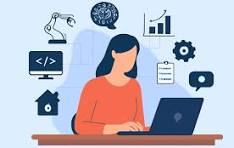Introduction
Duaction is a blend of learning and action, highlighting the need to utilize knowledge in real-life scenarios. Merely learning is not adequate; the knowledge acquired must be utilized at the very least in a timely manner. This blend enables the learners to receive immediate feedback, improve their mental models, and acquire practical skills more efficiently.
More simply, duaction is the link between practice and theory. This suggests that the quickest and surest way to grasp a concept is through actively engaging in doing.
How Duaction Works?
Duaction integrates active education strategies such as project-based learning, internships, or realtime problem solving with the theoretical components of schooling. Duaction facilitates immediate application of skills as opposed to waiting for the right moment. This includes:
Learning: Knowledge acquisition, for example reading, lectures, or research
Action:
Engaging in real-world tasks, exercises, or projects to implement the knowledge.
Feedback:
Providing responsive feedback and adjustments based on results.
Reflection:
Analyzing the experience in order to improve results with future actions.
Completing this cycle results in deeper learning and more effective skill development.
Why Duaction Is Important?
1 – Speeds Up The Collection of Skills
When learners are able to directly practice what they have learned, they acquire a better understanding of dealing with knowledge. Immediate practice ensures that skills are acquired much more quickly than the usual ways. Like, someone learning a programming language can quickly master the programming language if they are able to do small projects and apply what they have learned theoratically.
2 – Increases The Ability to Solve Problems
Duaction encourages a particular type of thinking that solves problems. While using learning in tackling real problems, the user is able to think of strategies to solve them. The ability to think in different perspectives and adapt to different methodologies is very important at all times in life and business.
3 – Increases Self-Esteem
When applied knowledge is put into practice, the learner stands to gain something once learning is done. This creates confidence and motivates the student to learn more. For example, students that are able to write a research paper or a business plan feel great to have learned the skill and they will want to go deeper.
Supports Lifelong Learning
Duaction promotes cyclic learning, which is actively doing something – learning. This is especially useful in technology, which is always changing, as it helps people advance in their careers.
Duaction in Action: Real-Life Applications
The Classroom: Project-Based Learning
Duaction can be observed in the educational method known as Project-Based Learning (PBL). It helps the learners to connect concepts to real life. In biology, for instance, students are taught the concepts of science and experiments. Later, they are given the chance to perform experiments which reinforces their learning.
The Workplace: Internships and Apprenticeships
The professional world also has duaction, which is exemplified by internships and apprenticeships. These positions provide learners the chance to apply their academic knowledge in real-life work settings. For instance, marketing interns first learn about consumer behavior, and then they practice it by executing social media campaigns.
In Personal Growth: Self-Directed Projects.
On a more personal level, goal-setting involving skill acquisition, such as photography, can illustrate how duaction works. After learning the fundamental principles of photography, they can immediately practice by trying to capture photos. The trying stage of learning allows people to enhance their learning and gives a sense of achievement.
The Benefits of Duaction
Higher Retention Rates
With knowledge retention, learning by doing will prove to be most effective. Students and professionals are more likely to internalize information if they practice what they want to internalize immediately. This information, once internalized, is then truly mastered, as opposed to being just committed to memory.
Greater Engagement
As previously stated, learning by doing engages more people. Motivation increases if the fruits of their effort can be clearly seen. Doing the actual tasks needed to achieve the learning objectives increases the learning experience and thus leads to a greater level of satisfaction.
Development of Transferable Skills
The skills and techniques acquired as a result of duaction are of great help and can be applied in many areas of life and work. Such skills will include, but not be limited to, critical reasoning, problem-solving, and flexibility. Whether in a project or a group, these skills aid academic achievement as well as real life.
How to Add Duaction to Your Learning Routine?
To blend duaction with your learning routine, here are a few useful tips to get you started:
Establish Specific Learning Objectives
Take a moment to think about what you want to learn. In what areas are you seeking knowledge? Balance your learning approach with real life applications. Every action you take should be steps toward achieving your knowledge goals.
Participate in Experiential Learning
Put your new knowledge into practice. For example, if you are learning about design, you can create sample logos and websites. If you’re a new learner of a language, you can make a practice of conversing with native speakers, writing, and doing language exercises.
Ask for Evaluation
Duaction’s central principle lies in constantly improving. Improvement begins with action, but doesn’t end there. After you take action, evaluate what you did and analyze what you would do next time in response to the feedback. This will help you to develop good understanding of the matter as well as help you to work toward the right solution.
Document Your Experience
Documenting tools such as journals help archive your thoughts. Documenting experiences and processes is very crucial to training. What else would you improve next time based on the lessons you gathered? This ensures constructive adjustments toward a desired outcome.
Duaction is an educational method which involves learning alongside practical application. It focuses on the learning process, which accompanies the gaining of knowledge, as well as its practical utilization in deepening comprehension.
Conclusion
The duaction paradigm has an innovative way of integrating education and practical work. With duaction, retention becomes enhanced and engagement escalates, along with the acquiring of important skills for life. Whether it is in a classroom, at work, or during self-improvement, the duaction method reshapes education with a focus on meaningful practical application.
FAQ’s
1 – Why is Duaction helpful in learning?
It enhances the rate of skill development due to the practical experience. It also improves problem-solving skills, boosts self-esteem, inspires engagement for learning and exploration, and promotes the desire to learn for the whole life.
2 – What is an example of duaction in your surroundings?
These include PBL (“Project Based Learning”) in schools, internships in the job market, and self-directed learning projects in which people seek new knowledge and immediately put it to practical use.
3 – What can I do to include duaction in my learning schedule?
Have an objective, perform an applied work project, solicit evaluation, and evaluate yourself. These are strategies that can help to ensure that the person is applying what he learns.
Key Takeaways:
Duaction integrates learning with action to improve understanding and the acquisition of skills in tandem.
It brings both personal and professional advancement through practical application.
Achieving duaction requires defined objectives, active learning, guidance, evaluation, and thoughtful self-assessment.



